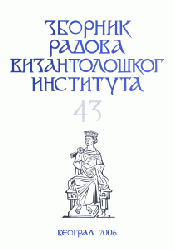O ikonografiji sv. Prokopija
On the Iconography of Saint Prokopios
Author(s): Smiljka GabelićSubject(s): Fine Arts / Performing Arts
Published by: Vizantološki institut SANU
Keywords: iconography; Saint Prokopios; cult
Summary/Abstract: The iconography of St. Prokopios (July 8) is understudied in comparison to that of the saints of the same category, such as St. George, St. Demetrios and St. Theodore (note 1, 2). The representation of the scene of Prokopios' Vision of the Cross is widely held to be confined to the 12th century Cappadocia (note 3). The vita of this saint is attested in two basic versions. Born in Jerusalem, the saint is described as a lecturer in the first version, whereas the second depicts him as a military commander. In both versions his name is Neanias; in the second one, he is said to have taken the name of Prokopios after converting to Christianity (notes 6-12). Byzantine synaxaria and other manuscripts mention a couple of saints carrying this name (notes 13-14). The oldest places of worship devoted to this saint are known only from written sources — Caesarea in Palestine, Gerasa, Constantinople, Scythopolis and Antioch (notes 15-17). At the end of the 12th (John Cinnamus) and the beginning of the 13th centuries (the correspondence between the Pope Innocent III and the Bulgarian Emperor Kaloyan), the relics of this saint and a church devoted to him in Nis are mentioned, but its traces have not been found yet (notes 18-20). There is in Prokuplje near Nis a restored medieval basilica of St. Prokopios, in which St. Prokopios' relics are said to have been transferred after the Turkish conquest of Nis at the end of the 14th century. The church in Prokuplje has only in part been archeologically investigated (notes 21-23); the relics of the saint were removed from there at the end of the 17th century (note 24). Not many churches in medieval Serbia were dedicated to St. Prokopios (note 25), which also holds true for the situation in Greece (note 26). St. Prokopios was always painted as a beardless young man with a hair of medium length, cut straight and combed behind the ears, dressed either as a nobleman (martyr) or as a soldier. Similar to other holy warriors, his soldier image became predominant from the 11th — 12th centuries (note 27). The first picture of St. Prokopios we know of, the one in the Church of Maria Antiqua in Rome, is not preserved, the oldest preserved ones coming from Cappadocia, among whose murals of the period from the 10th/11th to 13th centuries a number of representations of Prokopios survive (notes 28-30). It was in Cappadocia that the scene of the Vision of the Cross was formed, probably when the town of St. Prokopios (Urgup) near Caesarea became the seat of a bishop in the 10th century (notes 31-32)...
Journal: Зборник радова Византолошког института
- Issue Year: 2006
- Issue No: 43
- Page Range: 527-561
- Page Count: 33
- Language: Serbian

